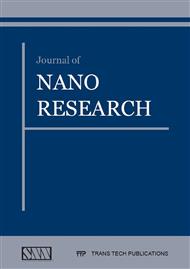[1]
Lundie, P.R., Drilling fluids: a challenge to the chemist, chemical in the oil industry, 3rd International symposium, special publication No. 67, Royal society of chemistry, (1988).
Google Scholar
[2]
Outmans, H.D., Mechanics of differential sticking of drill collars, Trans AIME, Vol. 213, pp.265-274, (1958).
DOI: 10.2118/963-g
Google Scholar
[3]
Isambourg, P. and Marti, J., Down hole simulation cell for measurement of lubricity and differential pressure sticking, SPE 52816, SPE/IADC drilling conf., Holland, (1999).
DOI: 10.2118/52816-ms
Google Scholar
[4]
Liu, X. and Civan, F., A multi-phase mud fluid infiltration and filter cake formation model, SPE 25215, International symposium on oil field chemistry, Louisiana, (1993).
Google Scholar
[5]
Civan, F. and Engler, T., Drilling mud filtrate invasion improved model and solution, Journal of Petroleum Science and Engineering, Vol. 11, pp.183-193, (1994).
DOI: 10.1016/0920-4105(94)90039-6
Google Scholar
[6]
Phelps, G. D., Computation of mud filtrate invasion profiles, Journal of Canadian Petroleum Technology, Vol. 34 (1), pp.18-27, (1995).
DOI: 10.2118/95-01-02
Google Scholar
[7]
Ramakrishnan, T.S. and Wilkinson, D.J., Formation producibility and fractional flow curves from radial resistivity variation caused by drilling fluid invasion, Journal of Physics of Fluids, Vol. 9, pp.833-844, (1997).
DOI: 10.1063/1.869483
Google Scholar
[8]
Porter, K.E., An overview of formation damage, Journal of Petroleum Technology, Vol. 41, pp.780-786, (1989).
Google Scholar
[9]
Xie, Y., Chen, Z. and Sun, F., Particles migrating and plugging mechanism in loosen sandstone heavy oil reservoir and the strategy of production with moderate sanding, 5th International Conference on Porous Media and its Applications in Science and Engineering ICPM5, Kona, Hawaii, June 22-27, (2014).
Google Scholar
[10]
Gray, D.H. and Rex, R.W., Formation damage in sandstone caused by clay dispersion and migration, 14th national conf. on clay and clay minerals, pp.355-366, (1966).
DOI: 10.1016/b978-0-08-011908-3.50033-5
Google Scholar
[11]
Muecke, T.W., Formation fines and factors controlling their movment in porous media, Journal of Petroleum Technology, pp.144-150, (1979).
DOI: 10.2118/7007-pa
Google Scholar
[12]
Vickers, S., Cowie, M., Jones, T., Twynam, A. J., A new methodology that surpasses current bridging theories to efficiently seal a varied pore throat distribution as found in natural reservoir formations, AADE Drilling fluids technical conference, Houston, (2006).
Google Scholar
[13]
Smith, P. S., Browne, S. V., Henz, T.J. and Wise, W. V., Drilling fluid design to prevent formation damage in high permeability quartz arenite sandstone, SPE annual technical conference and exhibition, Denver, (1996).
DOI: 10.2118/36430-ms
Google Scholar
[14]
Gruesbeck, C. and Collins, R.E., Entrainment and deposition of fine particles in porous media, SPE Journal, Vol. 22, pp.847-856, (1982).
DOI: 10.2118/8430-pa
Google Scholar
[15]
Abrams, A., Mud design to minimize rock impairment due to particle invasion, Journal of Petroleum Technology, pp.586-592, (1977).
DOI: 10.2118/5713-pa
Google Scholar
[16]
Chang, F.F. and Civan, F., Modeling of formation damage due to physical and chemical interactions between fluids and reservoir rocks, SPE 22856, 66th Annual tech. conf., Texas, (1991).
DOI: 10.2118/22856-ms
Google Scholar
[17]
You, Z., Bedrikovetsky, P., Badalyan, A., Hand, M. and Matthews, C., Formation damage and fines migration in geothermal reservoirs (modelling and field case study), Thirty-Ninth Workshop on Geothermal Reservoir Engineering Stanford University, Stanford, California, February 24-26, (2014).
DOI: 10.2118/158739-ms
Google Scholar
[18]
Jiao, D. and Sharma, M. M., Formation damage due to static and dynamic filtration of water-based muds, SPE 23823, SPE formation damage control symposium, Louisiana, (1992).
DOI: 10.2118/23823-ms
Google Scholar
[19]
Amanullah, md. And Al-Tahani, A.M., Nano-technology its significance in smart fluid development for oil and gas field application, SPE Saudi Arabian section tech. symp. And exhibition, (2009).
DOI: 10.2118/126102-ms
Google Scholar
[20]
Zhou, W., Heiney, P.A., Fan, H., Smalley, R.E. and Fischer, J.E., Single-walled carbon nanotube template crystallized of H2SO4: direct evidence for protonation, Journal of the American Chemical Society, Vol. 127, pp.1640-1642, (2005).
DOI: 10.1021/ja043131z
Google Scholar
[21]
Baghdikian, S.Y., Sharma, M. M. and Handy, L. L., Flow of clay suspensions through porous media, SPE Reservoir Engineering, Vol. 4, pp.213-220, (1989).
DOI: 10.2118/16257-pa
Google Scholar
[22]
Leontaritis, K.J., Asphaltene near wellbore formation damage modeling, Journal of Energy Resources Technology, Vol. 127, pp.191-200, (2005).
DOI: 10.1115/1.1937416
Google Scholar
[23]
Atkinson, G. and Mecik, M., The chemistry of scale prediction, Journal of Petroleum Science and Engineering, Vol. 17, pp.113-121, (1997).
DOI: 10.1016/s0920-4105(96)00060-5
Google Scholar
[24]
Sumer, M.P. and Serife, S.H., 2008, Solid-liquid two phase flow, First edition, Elsevier, Chapter 2, p.31, (2008).
Google Scholar
[25]
B.B. Mandelbrot, The fractal geometry of nature, W.H. Freeman, New York, (1983).
Google Scholar
[26]
King, R.W. and Adegbesan, K.O., Resolution of the principle formation damage mechanisms causing injectivity and productivity impairment in the Pembina cardium reservoir, SPE 38870, Annual technical conference and exhibition, Texas, (1997).
DOI: 10.2118/38870-ms
Google Scholar


